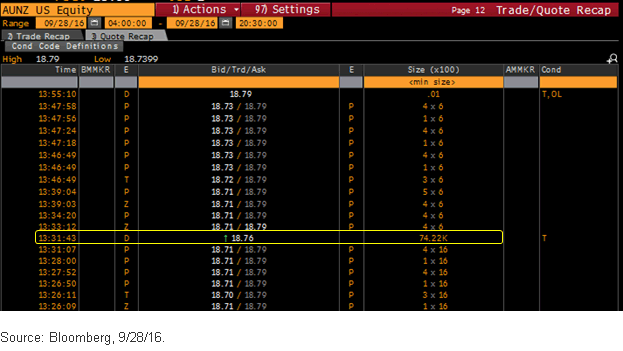Why This ETF Trade Should Be Celebrated


 This trade was possible because the liquidity capacity of an ETF is defined not by how many people buy and sell that ETF on a daily basis but by how much liquidity can be transferred to the ETF from other sources such as the underlying basket of securities and other correlated trading vehicles. In this example, the underlying basket of securities is comprised of local bonds in Australia and New Zealand. The estimated daily turnover of those bonds in the Fund is about $5 billion. So while $139 million seems like a lot when comparing it to the ADV of the ETF, it is a fraction of what the underlying securities trade and, therefore, what the ETF is capable of trading. This execution was possible because of liquidity that can be transferred to the ETF by the ETF market makers.
Liquidity Equality
This execution is not only a great example of liquidity potential but also the fact that the same liquidity is available on the way in and on the way out. Between the ETF issuer and the ETF investor lies the ETF market maker. The ETF investor will never send a check directly to the ETF issuer; instead, the money will always flow through market makers. The ETF market maker is issuer-agnostic and doesn’t really care whether an investor is buying or selling; it cares about the liquidity and cost of its hedge. One should never judge an ETF by the ADV alone and understand that there is no liquidity bias to the direction of the trade.
Assets Under Management (AUM) Don’t Equal Investment Capacity
It’s a common misconception that AUM levels are indicative of risk to the fund investors. In this instance, a large holder was able to exit the ETF with no discernible harmful effects to other investors. The redemption of 88% of the ETF assets barely had an effect on its value. As measured by the net asset value (NAV) of the Fund, the value of the underlying bonds actually went up 19 basis point (bps) the day of the redemption. The outstanding size of the bond issues in AUNZ is $420 billion. Again, $139 million is a fraction of that, and the underlying market absorbed it without impact. It is the notional value of assets that are tied to the investment strategy of the ETF that will dictate its investment capacity. Regardless of the number and size of shareholders in an ETF, the liquidity and capacity for investment typically remain the same.
The ETF Structure Can Help Protect Each Investor
AUNZ’s creation and redemption practices are generally done in-kind through an authorized participant (AP). This means that, in a redemption like this, the Fund itself doesn’t sell the bonds. Instead, the ETF delivers the underlying securities to the AP, which then trades those bonds in the open marketplace. This in-kind mechanism has a number of benefits to the other ETF holders. First, the transaction costs for every creation/redemption are borne by the AP and ultimately the one investor initiating the transaction. In the world of mutual funds, the portfolio managers buy and sell all the securities, and all of those transaction costs erode the NAV of the mutual fund every time any investor enters and exits. Second, the in-kind nature of the transaction allows the ETF to be more tax efficient and, via in-kind redemptions, capital gains in the ETF can be pushed out, minimizing the tax burden for the remaining investors. In this instance, one large investor was able to exit the Fund without causing undue costs or tax burdens to remaining investors. Third, in a traditional mutual fund expense structure, “other expenses” are paid by the fund to third parties for custody, accounting, administration and printing. The relative size of those other expenses increase as the asset size of the mutual fund decreases. However, for nearly all ETFs, including AUNZ, the investment advisor (WisdomTree, in this case) pays these “other expenses” out of its advisory fee. Hence, there is no additional risk of increasing expenses to ETF investors.
The ETF structure is one of transparency and equality. This trade is a perfect example of how investors are protected in the structure and how there is more to an ETF than its AUM and ADV.
This trade was possible because the liquidity capacity of an ETF is defined not by how many people buy and sell that ETF on a daily basis but by how much liquidity can be transferred to the ETF from other sources such as the underlying basket of securities and other correlated trading vehicles. In this example, the underlying basket of securities is comprised of local bonds in Australia and New Zealand. The estimated daily turnover of those bonds in the Fund is about $5 billion. So while $139 million seems like a lot when comparing it to the ADV of the ETF, it is a fraction of what the underlying securities trade and, therefore, what the ETF is capable of trading. This execution was possible because of liquidity that can be transferred to the ETF by the ETF market makers.
Liquidity Equality
This execution is not only a great example of liquidity potential but also the fact that the same liquidity is available on the way in and on the way out. Between the ETF issuer and the ETF investor lies the ETF market maker. The ETF investor will never send a check directly to the ETF issuer; instead, the money will always flow through market makers. The ETF market maker is issuer-agnostic and doesn’t really care whether an investor is buying or selling; it cares about the liquidity and cost of its hedge. One should never judge an ETF by the ADV alone and understand that there is no liquidity bias to the direction of the trade.
Assets Under Management (AUM) Don’t Equal Investment Capacity
It’s a common misconception that AUM levels are indicative of risk to the fund investors. In this instance, a large holder was able to exit the ETF with no discernible harmful effects to other investors. The redemption of 88% of the ETF assets barely had an effect on its value. As measured by the net asset value (NAV) of the Fund, the value of the underlying bonds actually went up 19 basis point (bps) the day of the redemption. The outstanding size of the bond issues in AUNZ is $420 billion. Again, $139 million is a fraction of that, and the underlying market absorbed it without impact. It is the notional value of assets that are tied to the investment strategy of the ETF that will dictate its investment capacity. Regardless of the number and size of shareholders in an ETF, the liquidity and capacity for investment typically remain the same.
The ETF Structure Can Help Protect Each Investor
AUNZ’s creation and redemption practices are generally done in-kind through an authorized participant (AP). This means that, in a redemption like this, the Fund itself doesn’t sell the bonds. Instead, the ETF delivers the underlying securities to the AP, which then trades those bonds in the open marketplace. This in-kind mechanism has a number of benefits to the other ETF holders. First, the transaction costs for every creation/redemption are borne by the AP and ultimately the one investor initiating the transaction. In the world of mutual funds, the portfolio managers buy and sell all the securities, and all of those transaction costs erode the NAV of the mutual fund every time any investor enters and exits. Second, the in-kind nature of the transaction allows the ETF to be more tax efficient and, via in-kind redemptions, capital gains in the ETF can be pushed out, minimizing the tax burden for the remaining investors. In this instance, one large investor was able to exit the Fund without causing undue costs or tax burdens to remaining investors. Third, in a traditional mutual fund expense structure, “other expenses” are paid by the fund to third parties for custody, accounting, administration and printing. The relative size of those other expenses increase as the asset size of the mutual fund decreases. However, for nearly all ETFs, including AUNZ, the investment advisor (WisdomTree, in this case) pays these “other expenses” out of its advisory fee. Hence, there is no additional risk of increasing expenses to ETF investors.
The ETF structure is one of transparency and equality. This trade is a perfect example of how investors are protected in the structure and how there is more to an ETF than its AUM and ADV.
Important Risks Related to this Article
There are risks associated with investing, including possible loss of principal. Foreign investing involves special risks, such as risk of loss from currency fluctuation or political or economic uncertainty. Derivative investments can be volatile and these investments may be less liquid than other securities, and more sensitive to the effects of varied economic conditions. The Fund focuses its investments in Australia and New Zealand, thereby increasing the impact of events and developments in Australia and New Zealand that can adversely affect performance.
Fixed income investments are subject to interest rate risk; their value will normally decline as interest rates rise. In addition when interest rates fall income may decline. Fixed income investments are also subject to credit risk, the risk that the issuer of a bond will fail to pay interest and principal in a timely manner, or that negative perceptions of the issuer’s ability to make such payments will cause the price of that bond to decline. Unlike typical exchange-traded funds, there is no index that the Fund attempts to track or replicate. Thus, the ability of the Fund to achieve its objective will depend on the effectiveness of the portfolio manager. Due to the investment strategy of this Fund it may make higher capital gain distributions than other ETFs. Please read the Fund’s prospectus for specific details regarding the Fund’s risk profile.
Neither WisdomTree Investments, Inc. nor its affiliates, nor Foreside Fund Services, LLC or its affiliates provide tax advice. All references to tax matters or information provided on this site are for illustrative purposes only and should not be considered tax advice and cannot be used for the purpose of avoiding tax penalties. Investors seeking tax advice should consult an independent tax advisor.


